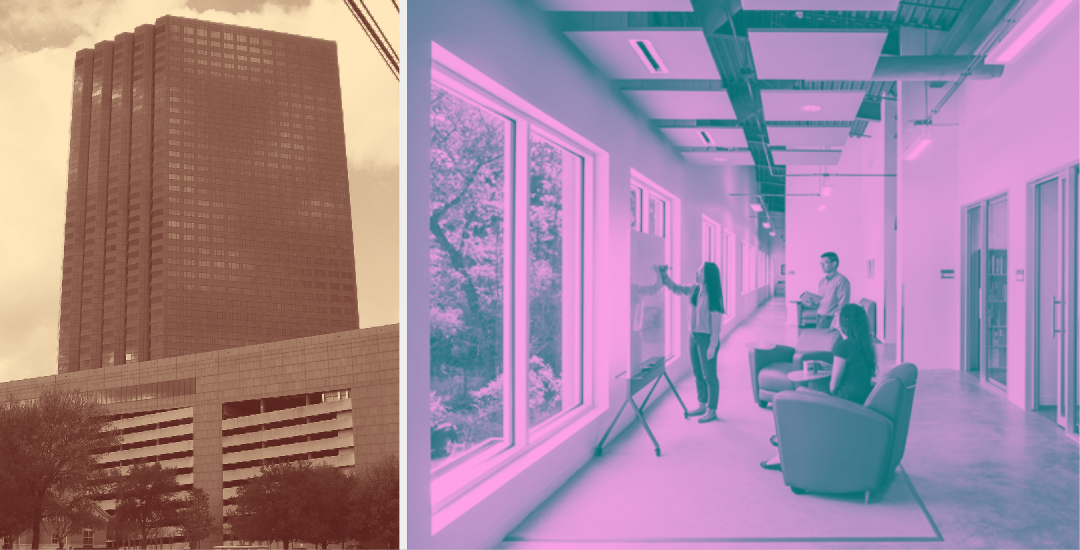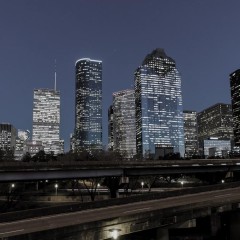In fact, a recent measure of return-to-work trends showed Houston office buildings had the highest occupancy rate among 10 major metros across the U.S. This sets up the Houston metro to be in somewhat better standing than markets such as Los Angeles and San Francisco, which have experienced high-profile office mortgage defaults in recent weeks.
Downtown Houston, a ghost town for many months after COVID-19 sent everyone home to work, is bustling again. And so are the largest submarkets outside the urban core — though at varying degrees. The Woodlands, Uptown and the Energy Corridor each have formidable downtowns of their own. Some are coming back faster than others.
The Woodlands
Rand Stephens, a principal for commercial real estate firm Avison Young in Houston, calls The Woodlands a “brighter spot” among other submarkets.
“They have a 14% vacancy rate vs. the city’s 22%,” he said, citing the direct vacancy rate, which doesn’t include sublease space.
Suburban office buildings tend to be newer and more attractive to companies looking to lease space. Abundant housing and lifestyle options have also helped the recovery.
“The Woodlands is a pretty compelling environment because it's a good place to work, play and live,” Stephens said.
Located about 27 miles north of downtown, The Woodlands/Spring was one of the few Houston submarkets to end the year with more occupied office space than it started with, according to data from Cushman & Wakefield, a commercial property firm.
“It never really felt like they really slowed down that much,” said Stephanie Burritt, co-managing director and principal of the Houston office of architecture firm Gensler. “Obviously they did a little bit, but it’s one of the most sought-after (areas) in America, so it keeps attracting businesses.”
Uptown
While Houston office workers are returning to their buildings in greater numbers than other big cities, the overall office recovery has been slow.
Among U.S. metros, Houston had the highest vacancy rate at the end of 2022, according to a report from Commercial Edge. At 25.8%, the rate was 1.43% higher than a year earlier.
The West Loop/Galleria area has been one of the hardest-hit submarkets. Office vacancy, including sublease space, was 29% at the end of last year, according to Avison Young.
Industry consolidation and companies moving farther west are driving up vacancies.
The former BHP Tower at 1500 Post Oak Blvd. is seeking tenants for much of its space. The company merged with Woodside last summer.
Marathon Oil recently left its Galleria-area tower at 5555 San Felipe St. to move into a new building on the Katy Freeway near Beltway 8. Apache Corp., too, is leaving its Post Oak Boulevard offices for west Houston.
Yet amid the vacancies, some developers spot opportunities.
Burritt said Gensler is discussing the possibility of designing a partial residential and hotel conversion for the 41-story former Marathon Oil Tower.
“Right now it’s just a study,” she said. “But it’s definitely feasible.”
Across submarkets, the newest buildings with the most amenities are outperforming older properties, data show.
Companies moving into these buildings are taking less space than they had before — even if their headcounts are growing.
This was happening even before the pandemic as new buildings became more efficient and offered more enticing perks, which companies use as a recruiting tool.
“That fight for talent is still very real,” Burritt said. “That need to attract talent is still very much driving real estate decisions around amenities.”
The Energy Corridor
In Houston’s corporate oil and gas hub, industry consolidation has for years reduced some of the demand for office space.
The Energy Corridor ended the year with a 24.3% total vacancy rate, Avison Young said. But like The Woodlands, the Energy Corridor posted positive office absorption at the end of 2022.
The Energy Corridor improvement district recently launched a branding campaign called “Redefining Energy” to help attract companies along the spectrum of the energy sector.
Plans for the area include investments in public art, infrastructure and mobility and “gateways” to help create a better sense of place for the geographically sprawling district.
Companies here were some of the first to formalize return-to-work plans. BP, for example, told its employees more than a year ago that it would implement a hybrid work policy: three days in the office and two at home.
And in a recent sign of strength for the area, Midway, the developer of CityCentre and East River, announced plans to transform the former ConocoPhillips office campus into a mixed-use complex with high-end retail, a luxury hotel, apartments and offices.
“It’s still a very vibrant area,” Stephens said. “There’s so much development out that way and so many rooftops, so you’re seeing positive absorption there — all along the Katy Freeway.”
Nancy Sarnoff, a longtime Houston business and real estate journalist, is a contributor to the Urban Edge.




